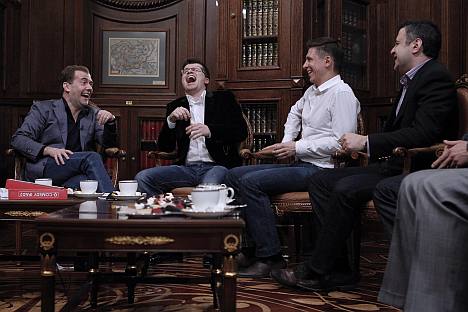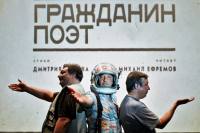Making Russians laugh

President of Russia Dmitry Medvedev shares a laugh with actors of Comedy Club TV show Igor Kharlamov, Timur Batrutdinov and Garik Martirosyan (L-R) at Gorki residence. Source: ITAR-TASS
Stand-up comedy is an individual act of moral striptease that makes up a huge chunk of Western humor. In contrast, Russian humor has developed out of a sense of collectivism – primarily, the KVN team contests.
The TV program KVN (Club of the Merry and Resourceful) involves a team of eight to 10 people who tell jokes while doing impersonations. They come up with jokes through brainstorming. The format appeared in the Soviet Union in the late 1950s at the dawn of television and was hugely popular. It triggered a nationwide KVN movement. Schools, universities and factories staged KVN games. Competitions to select those who would appear on the KVN television show were held at the country’s colleges and universities. The program was cancelled during the Brezhnev era of stagnation, but small clubs remained. This form of humor got a new lease on life when the format was revived during Mikhail Gorbachev’s perestroika.
Although Russian comedy owes a huge debt to KVN clubs, today Russian comedians have discovered new ways to make people laugh.
“Most people find it easier to talk about anything but themselves,” said stand-up comic Nikolai Kulikov. “In Soviet times and in the 1990s, we watched KVN teams come on stage, but not talk about themselves. They would have a slip of paper and say, ‘Aunt Sonya does this and that’ or ‘Russians are this and that.’ But they themselves were not there.”
This changed in the 2000s, when Russian television first bought the rights to American sitcoms and then started churning out its own. In 2005, the TNT channel developed a show called Comedy Club, and Humor FM radio station was launched. In 2006, comedy show Nasha Russia went on the air, and in 2007, singer-songwriter Pyotr Nalich conquered the Internet with his parody music video “Guitar.” But the legacy of KVN remained; the show became a national factory of television personnel, providing scriptwriters, program editors, presenters and stars.
The humor breakthroughs in the 2000s were symptoms of social change, reflecting current trends in Russian life. Russian society in the 2000s had fewer problems and more reasons to be cheerful than it did in the 1990s.
Politics: Funny or not?
In the 1990s, humor was heavily politicized; the NTV program Kukly (Puppets) epitomized this trend. The program was a take-off on popular works of art, historical events and personalities played by latex puppets modeled on Russian politicians, each story referring to current political realities and conflicts.
The program’s ratings sometimes reached 22 percent and newspapers discussed not only the politicians but also their puppet television look-alikes. The canons of political parody were established: President Boris Yeltsin drawled and his speech was full of interjections; Communist Party head Gennady Zhirinovsky spoke fast and staccato. But in 1999, political humor entered a new era.
The colorful and bumbling Yeltsin was succeeded by a leader without any eye-catching features: there was nothing about Vladimir Putin’s speech, looks or demeanor to make him instantly recognizable. Maxim Galkin, a popular TV presenter and parodist, said: “Yeltsin’s departure was a blow for many writers.” But the change in leadership paid off for Galkin. In the fall of 1999, he came to the mike with a glassy stare, visibly ill-at-ease, twitching his neck and diligently intoning the only words that were associated with Putin: “Good…amm…evening.” He became an instant star.
Many other parodists latched on to Putin’s studied reticence. Their Putin became more confident and more macho. Yet that seemingly apt image of the new president was also short-lived. Kukly was cancelled in 2002 after a change of leadership at NTV, which was taken over by the state-owned Gazprom. Censorship (or self-censorship) was only partially to blame.
“By the beginning of the 2000s, people were fed up with politics,” said Maxim Kononenko, creator of the site Vladimirvladimirovich.ru, which gave facetious descriptions of Putin in everyday life. “People became obsessed with consumption because they could afford it. Moreover, in the 2000s, domestic politics became more underground and the loud-mouthed political clowns of the 1990s vanished. They were replaced by colorless people in gray suits. To make fun of undercover politics, one had to know it very well,” Kanonenko said.
Kononenko’s Vladimir VladimirovichTM is not a stern politician but a contemplative character, occasionally pestered by opposition politicians and foreign leaders. Various events on the domestic scene are, more often than not, the result of some Duma deputy-android breaking down. The protagonists address one another tenderly as “brother.”
Kanonenko’s site ushered in a different kind of political humor, one that was not topical, but anchored in everyday life. Politics became the private business of ordinary people. In the sphere of popular humor, only the politician remained, a person like any member of the public that laughs at him, with the same weaknesses, joys and sorrows.
“We did not make political jokes, although we could say whatever we liked,” said Semyon Slepakov, writer and director of the sketch comedy program Nasha Russia. “But we weren’t interested; we were interested in things that our audience could identify with.”
Hitting below the belt
As humor concentrated more and more on daily life, it lost its edge and became more coarse. Comics told jokes about genitalia and bodily functions. This marked a regression from the cultural perspective, but from the social point of view, it was progress – many topics that had been taboo before could now be discussed on television.
Thanks to its brash arrogance in breaking taboos, the show Comedy Club became the most successful TV project of the decade. But Russian audiences soon became bored with the bawdiness. With the arrival of a new presenter, Garik Martirosyan, in 2011, Comedy Club changed and rude jokes disappeared from its skits.
Making fun of the rich
Yet it was not only the use of crass humor that made Comedy Club popular. It differed from the 1990s TV shows in that the audience was not an anonymous crowd but many Russian celebrities, who became the butt of often salacious and biting jokes. The layman’s laughter was a way to come to terms with wealth and glamour: making fun of the new rich of the of the 1990s was replaced by self-mockery in the 2000s.
“Russian humor in the 2000s”, says Garik Martirosyan, “is based on the same principles as the 1990s humor, with one ‘but.’ In the 1990s, these principles and trends had a triumphant ring to them, as if to say, ‘Hurrah! We have become rich. Hurrah! We now have sex. Hurrah! We have advertising. Hurrah! We can holiday anywhere in the world.’”
While the humor of the 2000s preserves these principles, the reaction to them changed. Euphoria gave way to critical reflection: “The wealth of many people has taken perverted forms. Advertising is a nuisance, TV shows are derivative and are all alike. We go on holidays to all parts of the world but, when we relax, the whole world tenses up,” Martirosyan said. Thus, revelry in glamour was soon replaced by self-castigation and a return to simple humanity.
The musical stars of the 2000s, who grew out of the Internet, are arguably the new leaders of contemporary Russian humor.
The first such star, in 2007, was Pyotr Nalivch, with his YouTube hit “Guitar.” Sitting in his battered Lada, a country bumpkin sings “Jump into my Jaguar” in broken English. His genre is poetic-musical parody, a genre as old and challenging as lyrical song: Bach and Mozart composed musical jokes. Nalich spoofs the lifestyle of a rural “macho man” and the musical structure of a romance, giving both the lowbrow and highbrow audience something to laugh at. Two years later, Nalich represented Russia at the Eurovision competition.
Integration through humor
As people became wealthier in the 2000s, a migration began to big Russian cities. The gap between incomes in Russian cities and in the Caucasus and Central Asia became so wide that migration assumed a mass scale, which was instantly reflected in humor. In the fall of 2006, the Nasha Russia show hit the TV screens. Derived from the British show Little Britain, it stars two protagonists, Ravshan and Jamshut.
They are guest workers who do repairs in the expensive apartments of wealthy Russians – a self-ironic reference to the mass craze for renovating Soviet-era flats that swept Russia in the 1990s and continues today.
The show’s gags follow the selfsame pattern: two ham-handed workers feel lost in the strange Russian environment and, with their poor command of Russian, cannot understand what the Russian boss says to them. They put their food on the top of an ancient grand piano and, when asked to paint a room, paint an LCD television for good measure. The cultural canon of a gruff Russian construction foreman clashes with the cultural canon of two Central Asians. Because they are so different, it is funny.
All of a sudden, Ravshan and Jamshut became popular not only with Russians, but also among migrant workers themselves: their community in Russia has yet to find a mouthpiece, and Nasha Russia is virtually the only public sphere where the ethnic minorities have a voice, be it only a comic one.
This comedy bridged the gap between Russians and those who quietly worked on their construction sites: Nasha Russia is the main source of information on guest workers, especially since Ravshan and Jamshut come across as thoroughly positive, engaging and even moving characters.
In that sense, the jokes about migrant workers portraying them in a positive rather than negative way might signify the first step towards integrating them into modern Russian society.
Russian stand-up
The popularity of Nasha Russia is waning, however, and there are signs that the era of individual stand-up comics is at hand. But this kind of comedy may be a hard sell in Russia.
“The main problem is that, in Russia, we have been taught to work collectively,” said Kulikov. “You come to a KVN club at 14–15 and the team begins to shape you. They tell you which jokes are good and which are not. You have no chance to test your own gags because your comrades tell you: ‘We know this audience, believe me, this joke won’t fly.’”
Kulikov belongs to the new generation of comics. He works alone in clubs. His jokes are about personal matters, friction with his father, his girlfriend having a fit of asthma while celebrating New Year. The audience laughs.
“A lot of what I speak about in my jokes is a result of some blunder of my own. Only, I don’t wait for somebody to point it out to me, I say, ‘Ha-ha, look, I made this blunder,’ and that is how I earn my living.”
The key to Kulikov’s success is his sincerity. The Russian stand-up of recent years is not a carbon copy of its Western counterpart; it is an entirely novel phenomenon. It is not so much a genre as a method of producing humor with universal appeal from an individual, not an institution. The emergence of such an independent attitude in Russia in recent years is a positive trend in all spheres, not only in humor. It is just that it is more noticeable in the realm of humor.
This article originally appeared in Russian in the Russky Reporter magazine.
All rights reserved by Rossiyskaya Gazeta.
Subscribe
to our newsletter!
Get the week's best stories straight to your inbox
